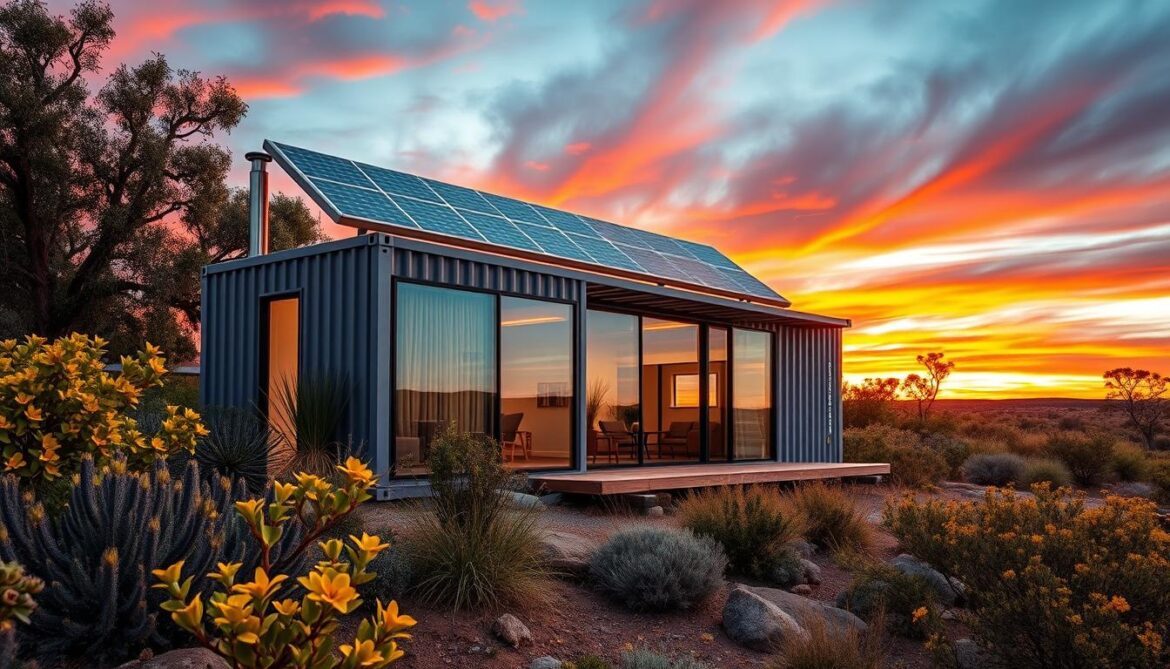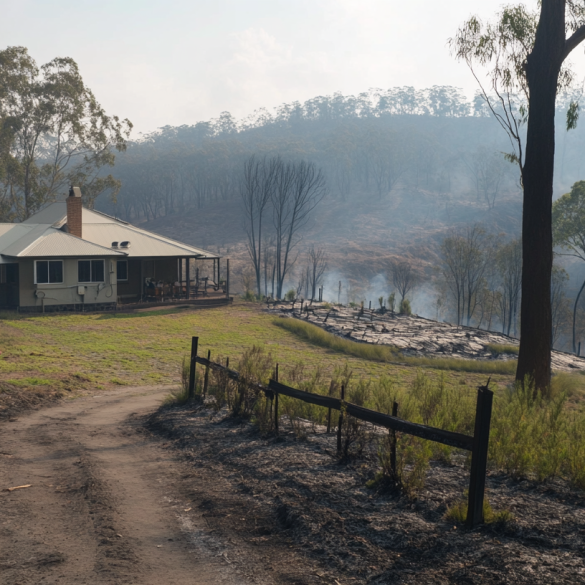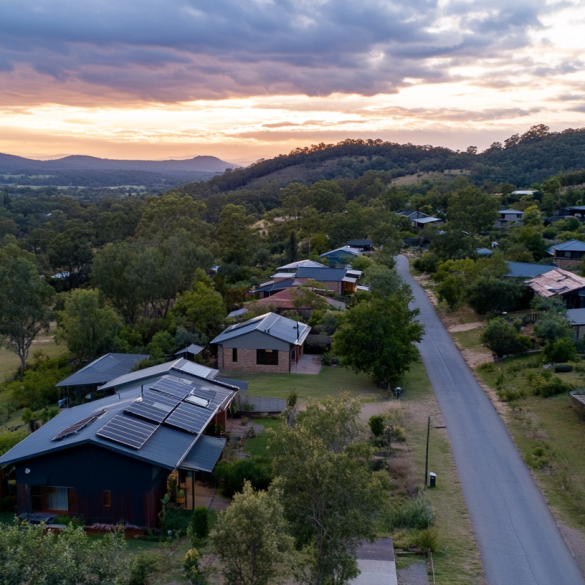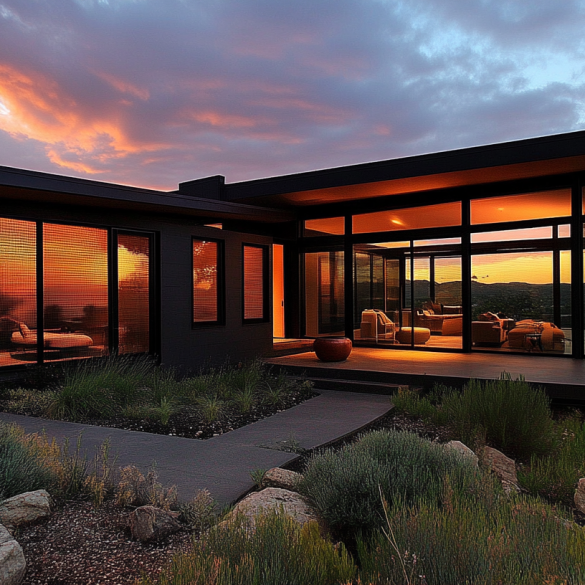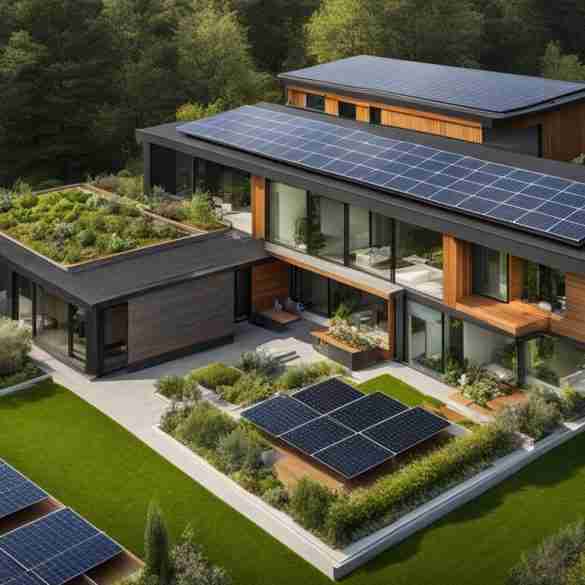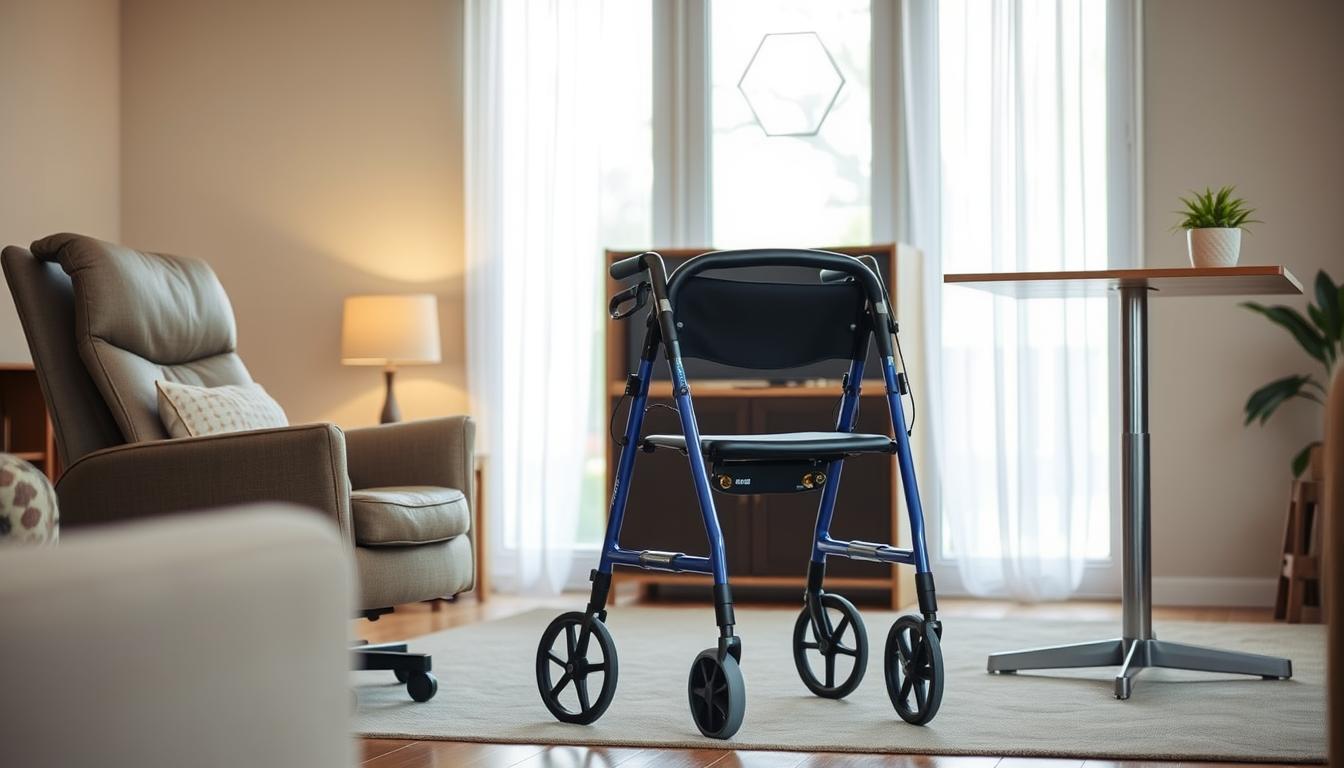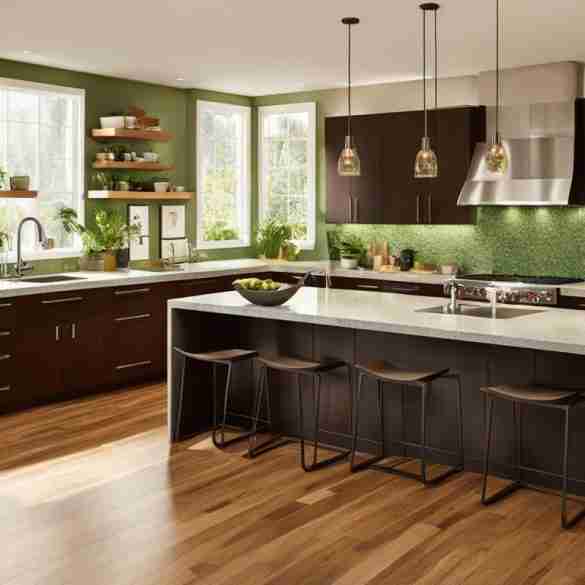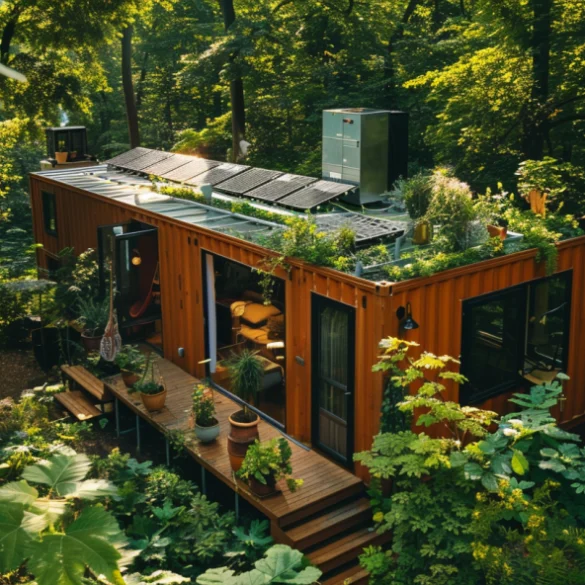Did you know a single home in Australia can use up to 31 shipping containers? It spans 450 square meters. This shows how big the potential of multi-container homes is in Australia. It’s changing the housing scene fast.
Container house design is changing how Australians live sustainably. These homes mix luxury, eco-friendliness, and new architecture. They offer a cool alternative to regular houses. You can find them in cities and countryside all over the country.
Modular housing in Australia is more than a trend. It’s a smart way to deal with high housing costs and environmental issues. These homes can be built in just 12 hours. That’s much faster than regular houses, which can take weeks or months.
These homes are not just practical. They can be very luxurious. For example, the Sky Ridge property in Kangaroo Valley sold for millions. It shows that you can live sustainably and in style. If you’re curious about these homes, check out Sustainable Home Magazine for more info.
Key Takeaways
- Multi-container homes in Australia can be constructed using up to 31 shipping containers
- Container homes can be assembled in as little as 12 hours
- Cost savings can be substantial, with some container homes costing less than half of traditional builds
- Luxury container homes have sold for millions, showcasing their market appeal
- Container architecture offers a blend of sustainability, modern design, and cost-effectiveness
Design and Layout Options for Multi-Container Homes
Multi-container homes offer many design options. They mix eco-friendly homes with affordable living. In Australia, these designs show new ways to live in portable spaces.
Single-Story vs. Multi-Story Container Homes
Single-story homes are great for small lots. Multi-story homes use space well on small land. The Graceville Container House, made from 31 cargo boxes, shows how to use space in Australia.
Open-Plan vs. Sectioned Layouts
Open-plan homes feel big and are good for parties. Sectioned homes give privacy, great for families. The Redpath Container Home in Australia mixes both, offering both openness and privacy.
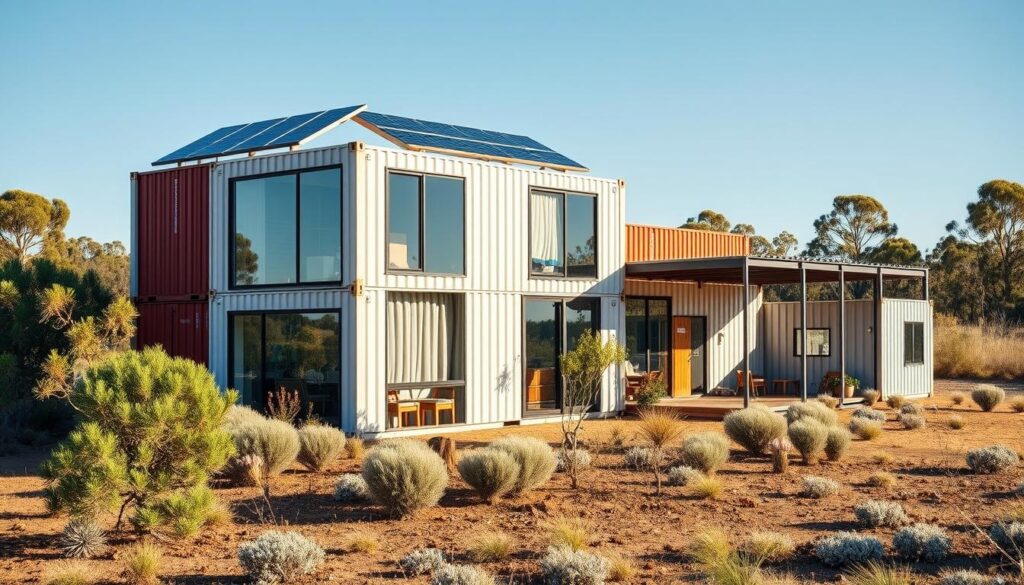
Maximizing Space and Functionality
Container homes need smart storage and furniture. The Kangarilla Shipping Container Home shows how to use space well. It proves you can have style and function in affordable homes.
Popular Architectural Styles
Australian container homes come in many styles. From industrial chic to modern minimalism. The Naylor Container Home, made from three containers, shows how light can make these homes special.
Sustainable Home Magazine talks about the VenSulation system by Sonic Steel. It helps with ventilation, insulation, and condensation. This makes container homes comfortable all year, no matter the weather in Australia.
Structural Integrity and Engineering Considerations
Building off-grid container homes in Australia needs careful planning. Prefab builders must follow strict rules. This ensures these homes can handle different weather.
Reinforcing Container Connections for Stability
Connecting containers is key for big homes. Engineers use special welding and strong joints. They add steel plates and beams for extra strength.
Load-Bearing Walls and Support Beams
Container homes need special walls and beams. These help spread weight evenly. Builders use strong steel beams, stronger than some other countries.
Wind and Cyclone Resistance for Australian Conditions
Australia’s weather is tough. Container homes are built to face winds over 150 km/hr. They have strong roofs and are anchored well.
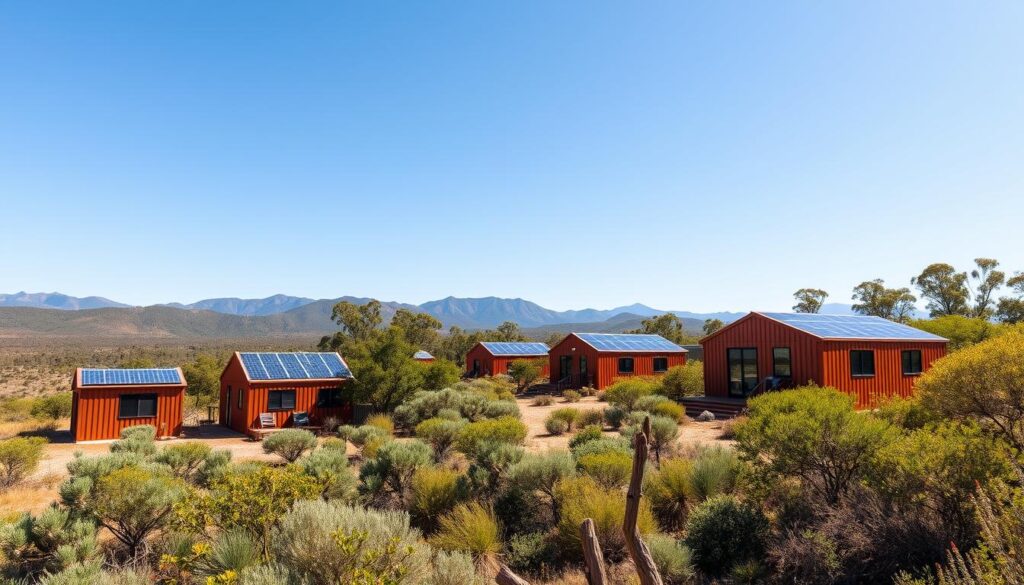
Earthquake and Bushfire Safety Measures
Keeping homes safe is important. For earthquakes, homes have flexible joints and strong foundations. For bushfires, they use fire-safe materials and create safe areas.
| Safety Feature | Purpose | Implementation |
|---|---|---|
| Reinforced Joints | Earthquake Resistance | Flexible steel connections |
| Fire-Resistant Cladding | Bushfire Protection | Non-combustible exterior materials |
| Wind Anchoring | Cyclone Resistance | Deep foundation ties |
By focusing on these engineering points, container homes in Australia are safe and strong. These homes are not just unique. They also face nature’s challenges well.
Cost Considerations for Multi-Container Homes
Building a multi-container home in Australia is a smart and affordable choice. We’ll look at the money side of these homes, from materials to permits. We’ll also compare them to regular houses.
Price Breakdown: Materials, Labor, and Permits
The price of shipping container homes in Australia changes with size and design. A small 15m² home costs between $20,000 and $42,000. A bigger 50ft home can be over $90,000.
Labor costs also change based on where you are. Prices per square meter go from $25 in Adelaide to $85 in Perth.
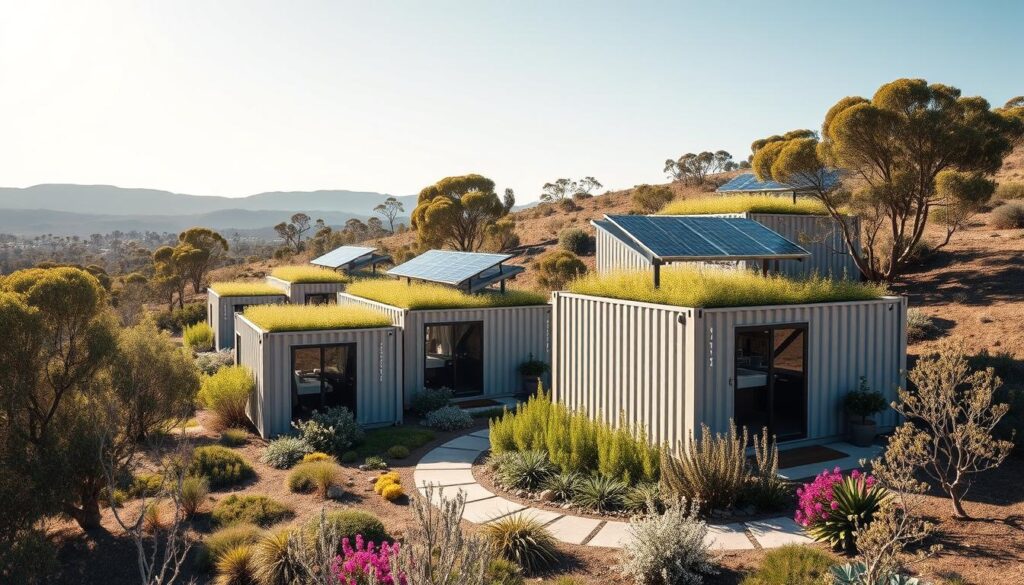
Cost Comparison: Multi-Container Homes vs. Traditional Homes
Modular container homes in Australia are often cheaper than regular houses. They cost about half as much per square foot. A two-bedroom container home might be up to $70,000. A similar traditional home would likely cost much more.
Budget-Friendly Design Tips
To save money, follow these tips for affordable container homes in Australia:
- Use high cube containers for extra ceiling height without extra cost
- Choose used containers in good shape to save on materials
- Keep structural changes to a minimum to cut labor costs
- Pick affordable insulation and flooring
Financing and Loan Options for Container Home Projects
Getting a loan for shipping container homes in Australia can be tough. But, some lenders offer loans for alternative homes. Look for local banks and credit unions that support these projects.
Check out Sustainable Home Magazine’s guides on budgeting for container homes. They can help you understand the financial side better.
“Container homes represent a unique opportunity to own a custom-built home at a fraction of the cost of traditional construction.”
Sustainability and Energy Efficiency
Eco-friendly container homes are changing the game in Australia. They mix affordability with caring for the planet. This makes them a great choice for those wanting to live sustainably.
Eco-Friendly Materials for Multi-Container Homes
Container homes use recycled steel and wood, cutting down on emissions. They also have durable paint that lasts over 15 years.
Solar Panels and Energy Solutions
Living off the grid is easy with advanced solar panels. Some homes have 4.15 kW panels and 7.0 kWh batteries. This gives enough power for everyday life.
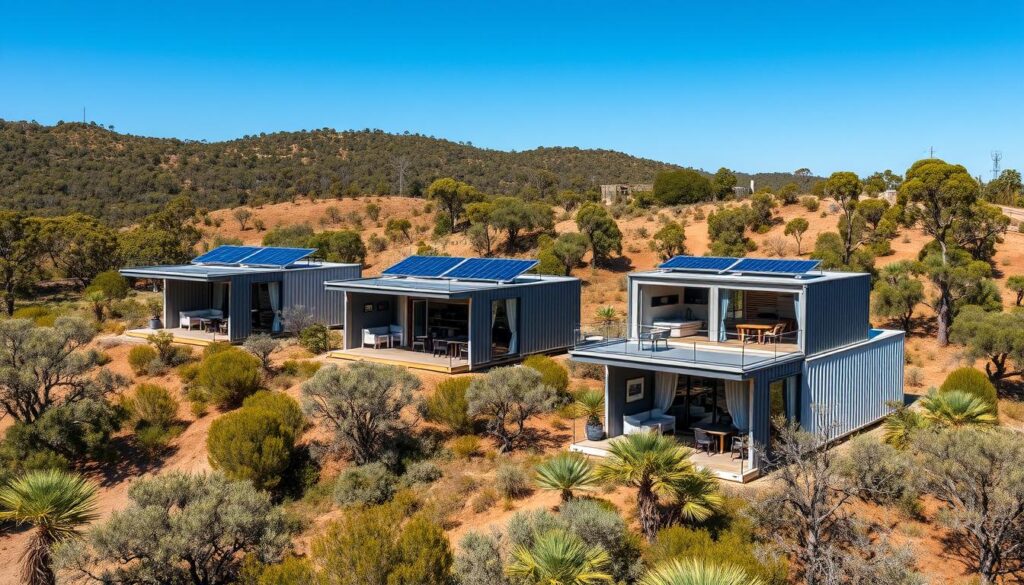
Water Harvesting and Greywater Systems
Water is precious in Australia, where droughts are common. Many homes collect rainwater and recycle greywater. This makes them both self-sufficient and eco-friendly.
Passive Cooling and Insulation Strategies
Container homes are very energy-efficient. They use special panels for insulation that keep the heat out. Some even have systems that save up to 85% of heat while using only 8W.
“Container homes represent the future of sustainable living, offering affordability, efficiency, and environmental consciousness in one compact package.”
Eco-friendly container homes in Australia are leading the way in sustainable living. They offer a mix of cost-effectiveness, efficiency, and care for the planet. This makes them perfect for those wanting to live green without giving up modern comforts.
Regulations and Permits for Multi-Container Homes in Australia
Understanding container home rules in Australia can be tricky. Homes made from shipping containers must follow many rules. These rules help keep people safe and make sure homes are comfortable.
Local Council Approval and Zoning Laws
Before you start your container home project, check local zoning laws. Some places don’t allow homes made from containers or tall buildings. You need a permit for homes that stay over 30 days.
Meeting Australian Building Codes and Standards
Container homes must be strong and safe. You’ll need plans from architects and engineers. It’s also important to have good plumbing, air, and fire safety, even in areas prone to fires.
Common Permit Challenges and Solutions
Many councils don’t know much about container homes. This can make getting permits hard. To help, show detailed plans and talk about the good things about container homes, like saving energy.
Legal Requirements for Off-Grid Multi-Container Homes
Off-grid homes use solar panels and collect rainwater. These green features might need extra approvals. Make sure you follow rules about keeping materials safe from pests.
“Container homes offer a unique blend of affordability and sustainability, but navigating the regulatory landscape is crucial for success.”
Knowing these rules helps you move forward with your dream of living in a container home in Australia.
Best Locations for Multi-Container Homes in Australia
Finding the perfect spot for your multi-container home in Australia is key. You can live in busy cities or peaceful countryside. Let’s look at the top places for your container home journey.
Urban vs. Rural Multi-Container Homes
City living means easy access to shops and jobs. You can use space wisely with stackable designs. But, rural areas offer more space and privacy. Your choice depends on what you like and local rules.
Ideal States and Regions for Container Living
Queensland and New South Wales are great for tiny homes. They have good weather and support for different homes. Western Australia and Victoria are also getting into container homes.
Climate Considerations by Location
Australia’s weather affects how you build your home. In tropical Queensland, you need good air flow and strong buildings. In the south, keep it warm with insulation. Near the sea, use materials that don’t rust.
Accessibility and Transport Considerations
Container homes are easy to move. But, getting to your site is important. Make sure roads can handle big containers. Also, think about how close you are to services. Many builders help with moving and setting up your home.
“Container homes offer unparalleled flexibility. From urban infills to remote retreats, they adapt to diverse Australian landscapes, providing unique living solutions.”
Remember, rules differ by place. Do your homework and talk to experts to find the best spot for your container home in Australia.
Custom-Built vs. Prefabricated Multi-Container Homes
In Australia, you can choose between custom-built and prefabricated multi-container homes. Each option has its own benefits. Let’s look at them to help you decide for your next home.
Pros and Cons of Custom vs. Pre-Made Designs
Custom-built homes give you total design freedom but cost more and take longer. Prefab homes are faster to build and might be cheaper. In Australia, prefab homes are becoming more popular, with a 60% increase in demand.
Best Australian Companies for Multi-Container Homes
Several Australian companies are known for their luxury container homes. Anchor Homes, for example, offers a 7-year warranty and 3-month maintenance. These builders have helped create over 200 homes in remote areas in two years.
Timeline and Cost Differences
Prefab homes usually take 2-3 weeks to set up. Custom homes take much longer. Modular homes cost about US$2700 per square meter, which is cheaper than traditional homes. This makes prefab homes 75% more affordable for first-time buyers.
Customization Options for Prefabricated Homes
Prefab homes are more flexible than you might think. They can look like shipping containers but are better insulated. They also meet the 7-star energy rating. Eco-friendly materials are used in 30% more prefab homes now.
| Feature | Custom-Built | Prefabricated |
|---|---|---|
| Design Flexibility | High | Moderate |
| Construction Time | Longer | Shorter (2-3 weeks) |
| Cost | Higher | Lower (US$2700/m²) |
| Energy Efficiency | Variable | Consistent (7-star rating) |
Multi-Container Homes for Families
Container house designs in Australia are changing to fit modern family needs. Multi-container homes are big and useful, perfect for family life. They also support eco-friendly living.
Creating Family-Friendly Layouts
Modular container homes in Australia focus on family comfort. The Cronulla home uses 8 x 20ft and 3 x 40ft containers. It has a big 3-bedroom, 4-bathroom layout. Plus, an office can turn into a fourth bedroom, showing how versatile these homes are.
Safety and Functionality
Safety is key in family container homes. They’re built strong to handle Australia’s weather. Big sliding doors make it easy to move between inside and outside, great for Sydney’s weather and family fun.
Storage and Multi-Purpose Spaces
Eco-friendly container homes use space well. They have lots of storage and areas that can be used in many ways. This is great for families who grow and change.
Best Floor Plans for Family Living
Popular floor plans for family-friendly container homes include:
- Open-concept living areas for family gatherings
- Multiple bedrooms (2-4) to accommodate children
- Flexible spaces that can serve as playrooms or study areas
- Outdoor living spaces for Australian family lifestyles
These homes are built fast, in as little as 6 weeks. Families can quickly move into their new, green homes. These homes offer a great life standard, are good for the planet, and save money. They’re a smart choice for Australian families looking for modern, efficient homes.
Multi-Container Homes for Investment and Rentals
Multi-container homes are becoming a big hit in Australia’s tiny home scene. They are cheap, green, and easy to move. This makes them great for investors and renters.
Profitability of Multi-Container Homes as Airbnb Rentals
The world’s container home market is set to hit $73,070.5 million by 2025. In Australia, these homes are making good money on Airbnb. They’re cheap to build and attract eco-friendly travelers.
Building one can take just a month. This means you can start earning money quickly.
Rental Income Potential and ROI
Investing in a multi-container home can be very profitable. Prices start at $90,000 for a 20ft container and $130,000 for a 40ft. This is much cheaper than regular houses, which cost around $500,000 in Australia.
The lower cost means you can pay off your mortgage faster. This can also lead to higher returns on investment.
Best Locations for Investment Properties
Central Queensland is a top spot for container home investments. Places like Rockhampton, Yeppoon, Gladstone, and Emerald are great. They’re safe from cyclones.
When picking a spot, think about tourism and local rules. Sustainable Home Magazine has tips on finding the best places.
Marketing Strategies for Container Home Rentals
To market your container home, focus on its special features. Talk about how eco-friendly it is. Mention its strong build against bad weather and pests.
Also, think about showing off at Tiny Home Expos in VIC, NSW, and WA. This can help you get noticed and might save on delivery costs.

